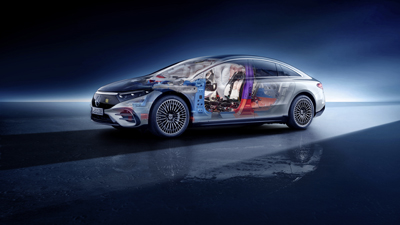Cid said this is helpful for first responders who need this information quickly following an accident and for insurance appraisers and body shops who may have never seen these vehicles before.
Many of Mercedes-Benz’s patents regarding occupant safety are open and available for other auto manufacturers.
“It has always been impressive to me to have a company to be able to provide that, especially when it comes to the safety of the occupants in the vehicle,” said Cid.
In addition to the safety aspects of an EV, another consideration is the process of painting an EV after a repair. “Sometimes, there are limitations on how hot the vehicle can get,” he said.
Cid stressed the importance of always checking the OEM repair procedures on the auto manufacturer’s website. OEM procedures can also be accessed on OEM1Stop.com.
“I don't think I can stress that enough on every single vehicle you're touching,” said Cid. “The excuse of ‘I didn’t know’ isn’t going to save you from what happens when the car goes out on the road with the customer if it has been improperly repaired.”
He said the safety aspect is not just about the liability after the repair; it's also the liability of everyone involved.
Another change Cid pointed out with EVs is the amount of charge the battery has when it leaves the shop. Previously, there wasn’t a major concern with ICE vehicles having a low fuel tank; however, this isn’t the case if an EV has a low battery and might not make it to the next charging station.
One of the standard requirements for Mercedes-Benz EV certification is having at least an 80% charge when delivered to the customer.
The EV Customer
During the company’s EV journey, Cid said the car manufacturer is finding customers have very different expectations with EVs and the reason for buying them.
“Customers tend to be more tech-savvy,” he said. “A lot of them weren't really interested in cars beforehand but now they’re buying EVs for all of the technology available in these cars.”
Talking to collision centers nationwide, Cid said many people who have adopted EVs early on tend to be very in tune with their cars. This may result in them calling the shop after noticing the battery is below a certain percentage or asking why their car was moved during the repair. In response, he recommends shops always put EVs in service mode.
“This is something that collision centers probably aren’t used to,” said Cid.
Looking ahead, Cid recommends shop owners and managers begin thinking about the types of vehicles they want to specialize in and invest in the tooling, equipment and training required to be successful.
To access Mercedes-Benz service and technical repair subscription information, visit www.startekinfo.com/home.
Learn more about Guild 21 at go.oeconnection.com/guild21.










Stacey Phillips Ronak